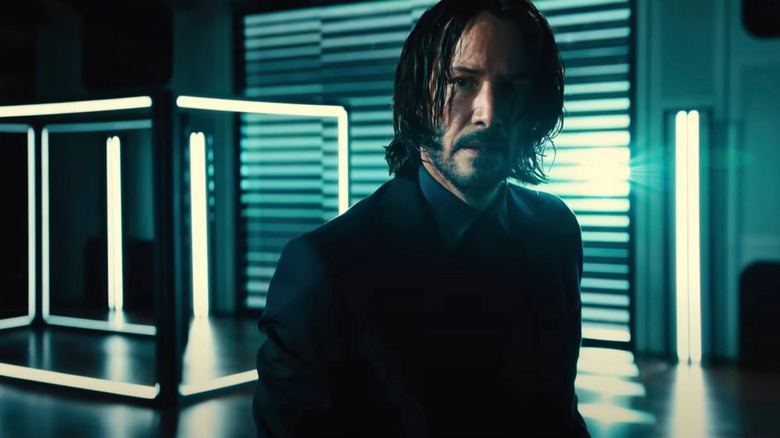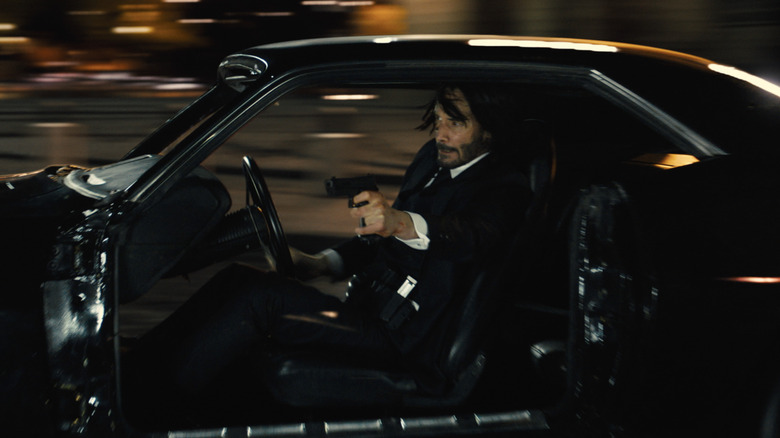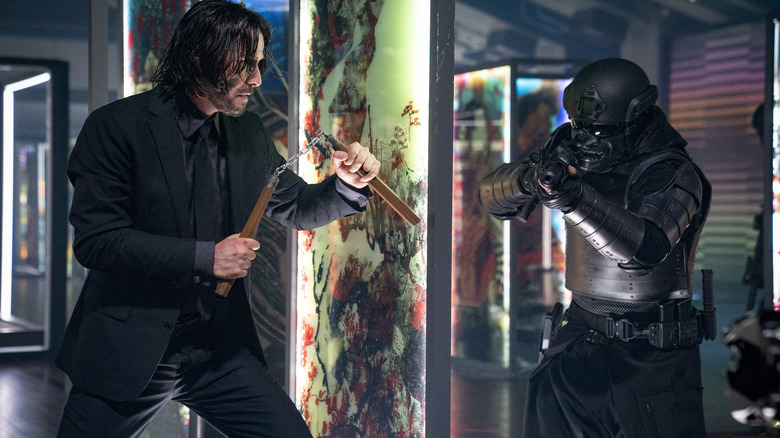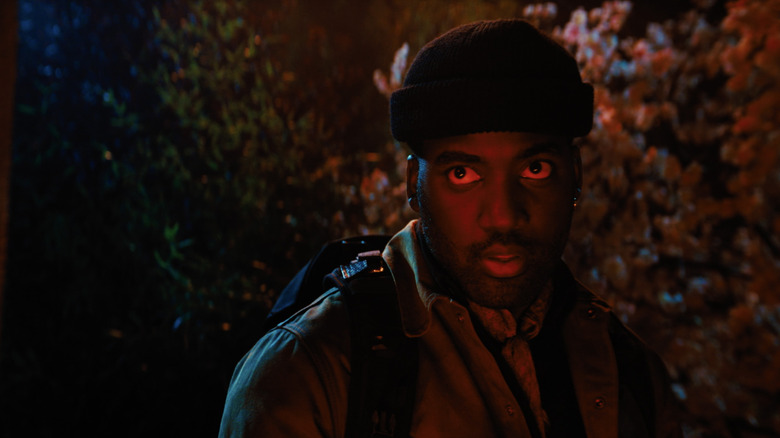John Wick: Chapter 4 Is Proof That An Action Movie Can Have Too Much Action
This post contains spoilers for "John Wick: Chapter 4."
In "John Wick: Chapter 3 — Parabellum," an unnamed homeless character played by comedian Jason Mantzoukas gravely warned the film's title character (Keanu Reeves) that his time was running out. Hundreds of assassins were closing in, John Wick had been excommunicated from his super-secret, high-class assassin guild, and the character appeared to be nearing the end of his rope.
Mantzoukas' grave invocation of the passage of time will be felt sorely by John Wick, by Keanu Reeves, and by the audience while watching Chad Stahelski's Greek mythology-indebted "John Wick: Chapter 4," a 169-minute cinematic explosion that is just as bogged down by action setpieces as it is strange, overwrought exposition about its own byzantine backstory. While the original 2014 "John Wick" was noted for the simplicity of its story and the lean, person-to-person action sequences, by "Chapter 4," Stahelski has become content to leave in every last shred of mayhem and complex worldbuilding, creating something that is more gristle than meat. "Chapter 4" is like three action films at once. By the film's end, Wick, Reeves, and the audience will likely all feel very, very tired.
The climax of "Chapter 4," for instance, is a lethal duel between John Wick and one of the film's villains. The terms of the duel are set, the rules laid out, and the stakes established. Wick picks up a gun, and heads to the duel's location. The film then pauses for 37 straight minutes (not an exaggeration) as John Wick fights his way across Paris. The action may be exciting, but an abundance of violence is not the same as a fast pace. Indeed, a lot of "Chapter 4" is nothing but dull dead stops, allowing Stahelski to indulge in poorly photographed fight scenes.
After the twelfth one, it's too much muchness.
More than we can stand
I should hasten to point out that the action choreography in "Chapter 4" is, as these things go, first-rate. There is a clever battle sequence early in the film wherein the blind assassin Caine (Donnie Yen) finds out where his prey is located by pasting motion-activated doorbell chimes on the walls of a kitchen. There are virtuosic shots wherein John Wick, driving a car without doors, cuts donuts around a group of attackers, mowing them down with a pistol. Because tuxedos are bulletproof in this universe, John Wick has to attack people's heads and necks, often requiring him to shoot his victims in the eye socket, then shoot them again to cause them to fall down and unobstruct his view of his next potential victim. On a visceral level, some of the violence is indeed thrilling.
But after so much of it, the eyes begin to gloss over. It certainly doesn't help that Stahelski's cinematographer Dan Laustsen (the Oscar-nominated photographer of "Silent Hill" and four Guillermo del Toro movies) seemed to be hellbent on obscuring the action's clarity, shooting in dark rooms or at nighttime, often employing soft focus, unusual neon color palates, and flickering strobes that leave even wide, one-take shots looking indistinct. It's like Nicholas Winding Refn tried to make a video game. That's not a compliment.
The viewer may be able to tell what's happening in a general sense — and thank goodness for small blessings — but the clear-eyed violence of the original "John Wick" is long gone here. It also doesn't help that Reeves, now 58, seems to be struggling through some of his more acrobatic stunt sequences. Three or four times, his backflips look like he and his fellow stunt performers barely made it.
Maior est melius
"Chapter 4" employs a "maior est melius" philosophy, and Stahelski seems to feel that if one action sequence is fine, then three in a row will be even better. A note to filmmakers: there's a reason why there are moments of conversation and rest in action movies. The audience needs to breathe every once in a while.
Back to that pre-climax action sequence in the film's last hour. It's essentially three action sequences in a row. In the first, John Wick engages in a deadly game of "Frogger" in the traffic around the Arc de Triomphe. Then he enters a dilapidated building, and there's a stultifying, video-game-like sequence filmed from the top down, wherein John Wick wastes a bunch of baddies using a flamethrower/shotgun weapon. Then, the pièce de résistance, he fights his way up to the top of the 222 stairs that lead to the forecourt of Sacré-Cœur in Montmartre. He'll make it to the top and then fall back down. One must imagine Sisyphus bloody.
The tri-sequence comes when the film is ready to conclude, so technically, none of the action is needed in a story sense, but one last "big fight" felt fitting for a beloved film series that is on the cusp of concluding. Because Stahelski couldn't choose which of the three sequences he wanted to serve as his "big fight," however, he merely included all three. The result makes "Chapter 4" feel like an unpolished workprint, a thrilling, violent, slam-bang climax that never stops climaxing. Some of us wish it would, merely to save the pace of this nearly three-hour slog.
Extra characters
The complex "John Wick" timeline mythology of the "John Wick" movies is a topic for another day, only to say that it's become incredibly involved by "Chapter 4." Various crime bosses with various connections to The High Table — the highest bureau of assassins on Earth — get mixed into the action, and an entire portion of the movie is devoted to John Wick attacking a Russian mobster merely to gain favor from a different crime boss. The plethora of villains isn't so much an issue as the additional heroes. Pop star Rina Sawayama plays a character named Akira, the daughter of an Osaka hotelier (and recall, this is a universe where certain hotels are neutral grounds for its many, many assassins). She, like every character, wears a badass assassin outfit and is trained in weapon use. Her function in the film is ... to be another one of those.
More grievous is the film's ancillary use of Mr. Nobody (Shamier Anderson), a sniper with a well-trained dog who, when action sequences begin, kind of just shows up to amplify the gun fetishization of the entire series by firing a few more bullets into the fray. "Chapter 4," it seems, added entire extra characters just to beef up its action sequences. It then failed, however, to give those same characters anything interesting to do beyond fight. Mr. Nobody seems keen on earning a lot of money in the assassin market, but to what end? Even if he had said, "I just wanna be rich," it would have been something.
There is a trim, exciting 95-minute movie lurking inside of "John Wick: Chapter 4." The film we got is action to excess, pushing things beyond logic, good pacing, or the realm of interest. I only have so much adrenaline.



